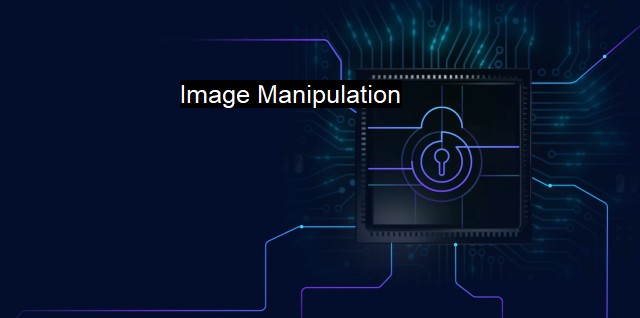What is Image Manipulation?
Image Manipulation and its Malicious Intent: A Comprehensive Exploration of a Growing Cybersecurity Threat
Image manipulation is the alteration or transformation of an image using various methods and techniques to create an illusion or to trick individuals into seeing something different from the original. In the age-digital world, this process is mostly achieved through the use of advanced software tools and applications. While it is more prevalent in fields like photography and filmmaking where manipulations are done to improve the image's aesthetics, a more nefarious application has emerged in recent years with significant implications on cybersecurity.A major concern for cybersecurity personnel is the use of manipulative imagery in breaching security protocols. Often these manipulations can be quite subtle, merely placing disguised malware or malicious code onto legitimate images. This form of attack, referred to as steganography, hides harmful payloads inside ordinary files that can today be distributed unsuspectingly to billions of users via social media, emails, and even communication apps. image manipulation in this context is a form of veiled attack and threat to users, and it is a continuously evolving challenge for antivirus systems.
One of the most common manipulative tactics is known as a ‘drive-by download', where an image is corrupted such that it automatically starts downloading malware as soon as it is opened by an unsuspecting individual. The approach attacks the endpoints of the cybersecurity chain, targeting the devices which often are the weakest point in personal security set-ups. This targeted attack could reveal sensitive data, be it banking information, personal address and contact details, or even access to confidential info within a secure network. Antivirus software now has to become 'smarter' to adapt and identify these passive-aggressive forms of attack on systems.
Image manipulation is also utilized by cybercriminals in the form of “phishing”, seeking to trick individuals into believing that the modified image stems from a legitimate and trusted source. Beneath such images, potent malware or phishing code could be hidden that can lure the user into unveiling sensitive information. The arbitrary metadata of an image such as the geolocation, the date, or even the device details can also be manipulated by attackers to falsify critical information, building a veil of deceit and suspicion.
On other fronts, the rise of deepfakes represents another unsettling application of image manipulation. By employing artificial intelligence (AI) algorithms, these techniques generate a believable facsimile of target individuals, often high-profile figures, in misleading or damaging contexts. While deepfakes primarily concern video rather than still imagery, they attest to how far image manipulation has come and how influential it could be in damaging reputations, swaying public opinions, or influencing political outcomes.
To mitigate these ongoing risks associated with image manipulation, antivirus and cybersecurity solutions are rapidly evolving. Utilizing machine learning and artificial intelligence, these solutions are learning to recognize manipulated data better, in images and beyond, to alert users about potential threats. Cryptographically sealed digital watermarks and reverse image search tools are also being employed more widely to detect manipulated images, enabling users to verify an image's origin and integrity.
In the long run, individuals must also adapt to this new reality by becoming more discerning, remaining vigilant for any irregularities, and ensuring their antivirus is always up-to-date. Image manipulation, through all its applications, claims validity to the old adage "seeing is no longer believing". In our interconnected world, it is buoying itself in unexpected places to dominate personal data space, urging us into a new battleground where every pixel, subtly manipulated, could be a ploy to disarm individual privacies and shared online security.

Image Manipulation FAQs
What is image manipulation in cybersecurity?
Image manipulation in cybersecurity refers to the process of modifying digital images with malicious intent. Cybercriminals use these manipulated images as a tool to distribute malware and exploit vulnerabilities in computer systems.How does antivirus software protect against image manipulation?
Antivirus software uses various techniques to protect against image manipulation. The software scans images for suspicious code or hidden malware that may be embedded in them. It also detects any attempts by malicious actors to modify images without authorization. This helps to prevent the distribution of infected images and protects computer systems from cyber attacks.What are some common types of image manipulation attacks?
Some common types of image manipulation attacks include steganography, which involves hiding secret information within an image, and image spoofing, which involves forging or faking an image to deceive users. Other types of attacks may involve manipulating images to contain malicious code or using them as a social engineering tool to trick individuals into performing actions that compromise their system security.How can individuals protect themselves from image manipulation attacks?
Individuals can protect themselves from image manipulation attacks by being cautious when downloading or opening images from unknown sources. They should also use antivirus software and keep it up to date to ensure that their system is protected from the latest threats. Additionally, it is essential to practice safe browsing habits and avoid clicking on suspicious links or attachments that may contain malware or other harmful software.| | A | | | B | | | C | | | D | | | E | | | F | | | G | | | H | | | I | | | J | | | K | | | L | | | M | |
| | N | | | O | | | P | | | Q | | | R | | | S | | | T | | | U | | | V | | | W | | | X | | | Y | | | Z | |
| | 1 | | | 2 | | | 3 | | | 4 | | | 7 | | | 8 | | |||||||